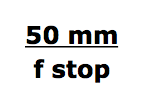Changes in the Circumference
What happens to the circumference of a circle if you double the diameter? If you triple the diameter? If you halve the diameter? As the diameter increases (or decreases) in measure, how does the circumference change? Why does this change occur?
![]() Extension:
Extension:
Camera lenses have a diaphragm that controls the aperture, the opening which allows light to pass through to the film.

For example, in the picture above, the outer circle is the lens and the inner circles are the diaphragms. Note that the size (area) of the aperture can change. A larger aperture allows more light to pass through. The size of the aperture is determined by the f numbers (also called f stops). A typical 50 mm lens has the following f stops: f 2.8, f 4, f 5.6, f 8, f 11, f 16. The diameter of the aperture is determined by the fraction

Compare the amounts of light passing through a 50 mm lens for various pairs of f stops. How much more light passes through f 4 than f 16? Through f 2.8 than f 5.6? Try to generalize any patterns you find. Test your conjectures on a 120 mm lens with the same f stops.
